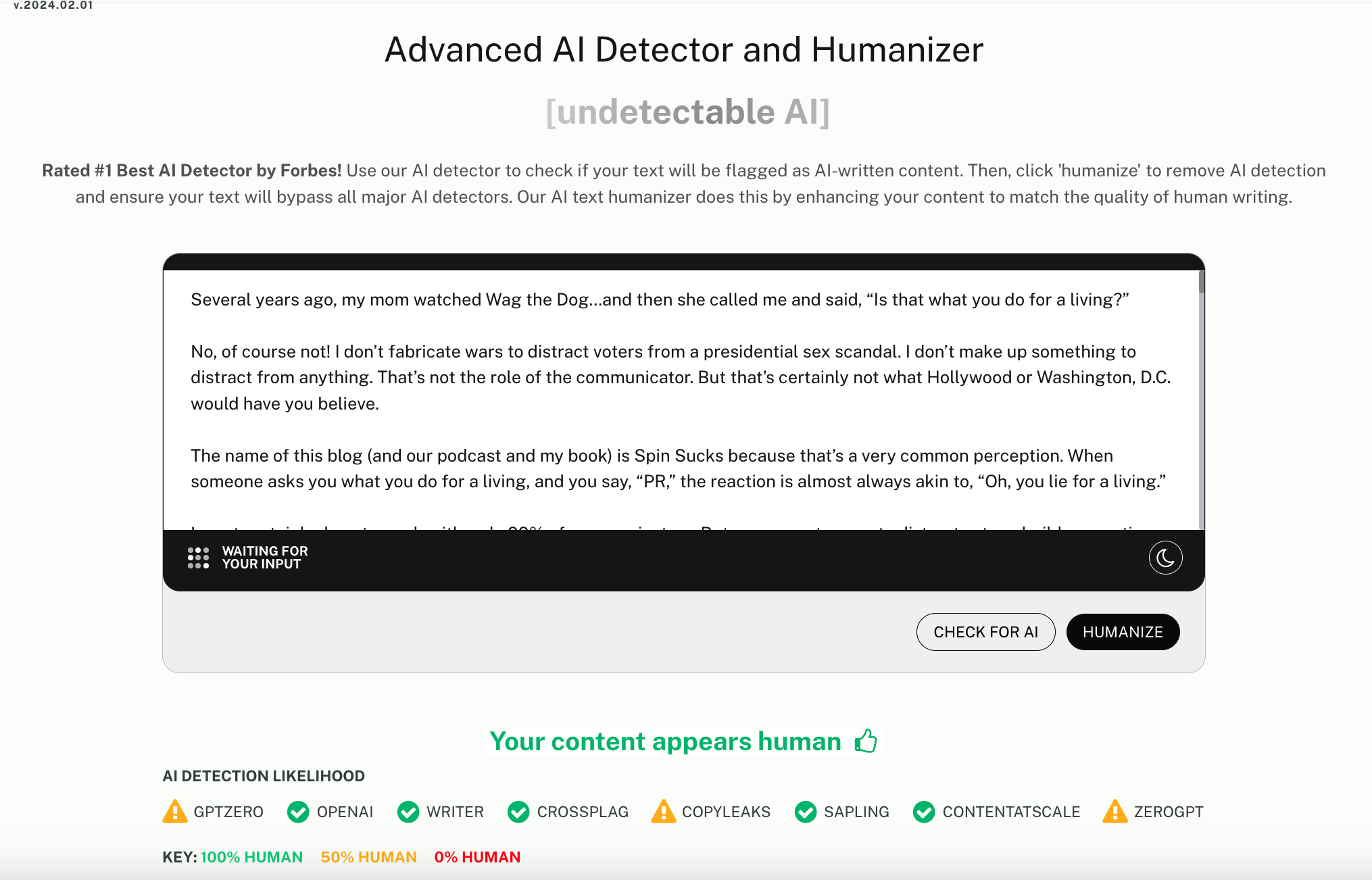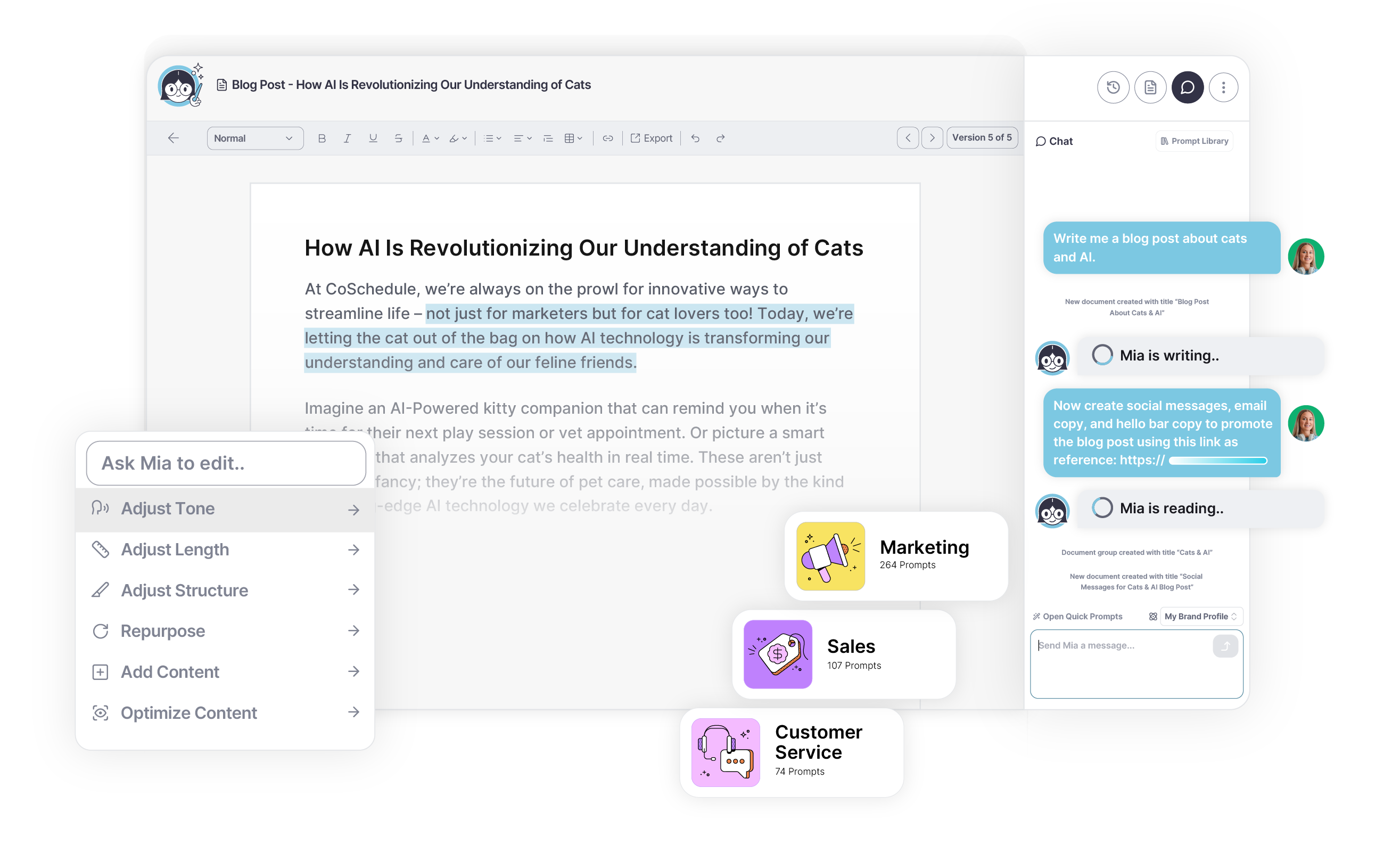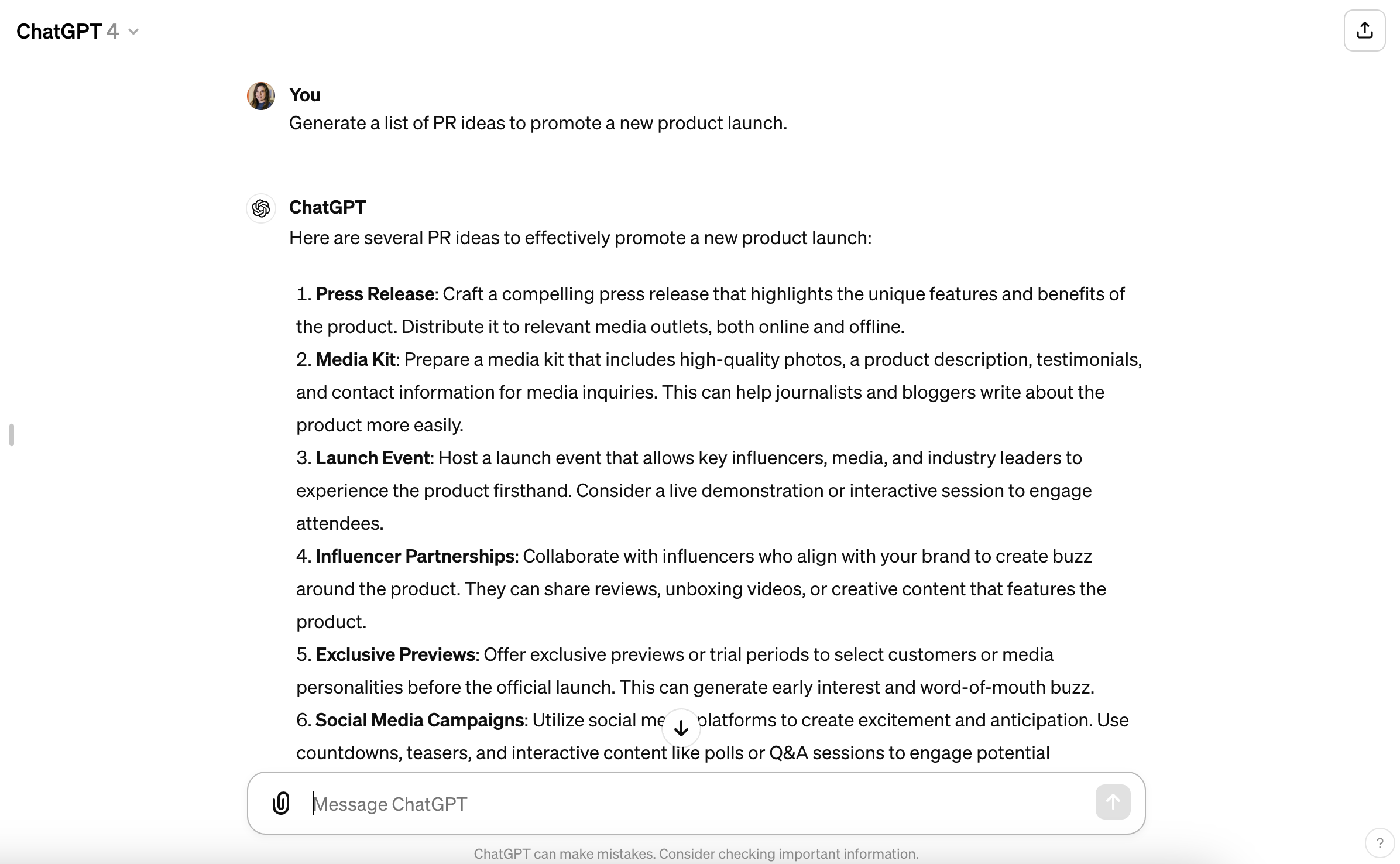PR professionals constantly seek ways to streamline their busy days and achieve better outcomes. AI promises to change public relations, but can it truly enhance this field without jeopardizing its core principles?
 Lindsay Scheidell, founder of Hadley PR, sees AI as a means to “enhance everyday efficiencies at work.“
Lindsay Scheidell, founder of Hadley PR, sees AI as a means to “enhance everyday efficiencies at work.“
She explains, “Consider AI-supported media monitoring as an example. I’d much rather spend a chunk of my day building strategy and pushing creative work than spend more time tracking down exposure.”

In this guide, we’ll discuss how you can integrate AI seamlessly into PR practices to enhance your strategy and boost efficiency.
The Introduction of AI In Public Relations
Thanks to AI, traditional methods are rapidly evolving.
For instance, manual media monitoring and labor-intensive data analysis are already becoming obsolete. PR professionals now have access to AI algorithms that can sift through vast amounts of data, extracting actionable insights and hidden patterns to inform their strategies.
You’re likely aware of how digital channels reign supreme in today’s PR landscape. However, the sheer volume of information can be overwhelming. AI acts as a guide, helping you navigate this digital maze by identifying relevant conversations, trends, and influences that shape brand initiatives.
Moreover, AI tools transform how PR campaigns are conceived, executed, and evaluated. You can craft messages that better resonate with your target audience through strategic sentiment analysis and prediction.
As AI adoption in PR grows, embracing this technology will give you a competitive edge. The key is to leverage AI alongside human expertise to enhance brand visibility and build stronger relationships.
Benefits of AI for PR Professionals
AI in public relations offers a multitude of benefits for professionals, including:
- Real-time Media Monitoring: With AI-powered media monitoring, you can track brand mentions, monitor industry trends, and stay ahead of competitor activities across various digital channels. This enables prompt responses to emerging issues and strategic shaping of PR campaigns.
- Personalized Communication: Accenture’s research underscores the significance of personalization, with 91% of consumers expressing a preference for brands that offer tailored recommendations. Using machine learning algorithms, you can analyze extensive datasets to better understand a brand’s audience preferences, behaviors, and sentiments and personalize communication.
- Efficient Press Release Distribution: AI facilitates precise targeting of journalists and influencers, ensuring that press releases reach the right people at the right time.
- AI-powered Reporting and Analysis: AI-driven reporting and analysis tools provide detailed insights in real time, simplifying the process of tracking and measuring ROI. Deloitte’s findings indicate that organizations using automation see significant time cost-savings, boosting efficiency.
- Advanced Content Creation and Optimization: With natural language processing (NLP), you can quickly generate high-quality press releases, blog posts, and social media content. AI-driven content optimization tools further refine messaging based on audience behavior and preferences.
Idea Generation and Brainstorming
Brainstorming and automating content are obvious use cases of AI in public relations. Here’s how to approach it:
Generate Ideas
When it comes to generating ideas, AI-powered tools are indispensable. They can analyze current trends and historical data to suggest fresh perspectives and new angles for your brainstorming sessions. This means lots of fresh and creative ideas for your PR campaigns.
Receive Data-Driven Inspiration
AI can also help you find inspiration in numbers. It sifts through vast amounts of data to uncover patterns and insights that humans might miss. You gain a deeper understanding of your target audiences, which can help you develop more effective strategies. Think: new campaign angles, identifying untapped audiences.
Enhance Creativity with AI Prompts
Introducing AI prompts challenges conventional thinking. You’re pushed to think differently. For instance, AI might suggest combining unrelated concepts to create something new. This prompts your team to explore unique combinations that lead to breakthrough insights and creative campaigns.
Analyze Sentiment to Tailor Messaging
AI-powered sentiment analysis tools tell how people feel about your brand or message. You gain a nuanced understanding of audience perception by analyzing sentiment in online discussions and news articles. You can then adjust your messaging to fit what your audience wants to hear, learning to make stronger connections and boost engagement.
For instance, if sentiment analysis reveals that a particular topic generates negative reactions, you can adjust their messaging to address concerns or pivot to a more positive angle.
Collaborate In AI Workspaces
Imagine working with AI in a virtual brainstorming room. AI-driven platforms help you and your team collaborate in real time, using AI suggestions to improve your ideas. These platforms analyze data and trends, offering insights and inspiration to fuel creativity. You can combine your team’s expertise with AI’s insights to develop better campaign concepts.
Repurpose Content Across Multiple Platforms
Lastly, you can use AI to increase your PR content’s mileage.
Here’s how:
Scale Content Production for PR Campaigns
AI-driven tools streamline content creation processes, facilitating high-quality content at scale. They handle repetitive tasks, like drafting press releases and social media posts so that you can focus on bigger-picture planning and brainstorming.
Tailor Content for Different Platforms
AI algorithms analyze audience behavior and preferences, which is useful for tailoring content for maximum impact on various social media networks. Whether it’s adapting messaging for Twitter, Instagram, or LinkedIn, AI ensures your content fits perfectly on each platform.
Automate A/B Testing
AI-powered A/B testing crunches performance data and user feedback quickly, pinpointing the most effective content variations. Thus, you can fine-tune your PR campaigns confidently, knowing you’re delivering the best possible results.
Analyze Data And Monitor Trends
Here’s how you can leverage AI to analyze data and monitor trends to inform your PR strategies:
- Natural Language Processing (NLP): AI-powered NLP analyzes mountains of text data from news articles, social media, and more. It spots trends, gauges sentiment, and pinpoints key topics relevant to your PR goals. By analyzing this information, you stay in the loop about public opinions, letting you tweak your strategies as needed.
- Predictive Analytics: AI analyzes the past to predict the future. By crunching historical data, it forecasts upcoming trends and behaviors. This means you can foresee potential challenges or opportunities and adjust your strategies in advance to capitalize on emerging trends or avoid pitfalls.
- Social Media Listening: AI-powered social media listening tools can monitor conversations across various social media platforms to identify relevant topics, emerging trends, and sentiment toward your brand or industry. They keep you on top of social media chatter, helping you seize chances for engagement and address potential issues early on.
- Competitor Analysis: AI isn’t just looking at your data—it’s keeping an eye on the competition too. It analyzes what your rivals are up to, from their PR moves to social media buzz. You can compare notes and tweak your own strategies to stand out and capitalize on market opportunities.
Integrate AI Into Your PR Processes
Below is a quick rundown of integrating AI tools into everyday PR tasks.
- Enhance Media Relations with AI: Use AI tools to customize your messages for journalists and media outlets. Look at data to see what they like and have covered before. Tailoring your pitches to their interests helps build better relationships.
- AI in Crisis Management: During PR crises, employ AI to monitor social media, news, and online conversations about your brand in real time. This way, you can respond quickly and handle issues before they worsen.
- AI-Driven PR Measurement and Evaluation: Use AI tools to track media coverage, audience sentiment, and engagement. This will help you make smarter decisions and demonstrate the value of your PR work.
- AI for Audience Segmentation: To better understand your audience, use AI to analyze different types of data, such as age, behavior, and interests. Based on the insights, you can group people into different segments and talk to them using targeted communication strategies.
- AI-Powered Influencer Marketing: AI also finds suitable influencers for your brand. It looks at who’s influential and what they talk about, then suggests potential collaborations. This helps you reach more of your target audience effectively.
- Automated PR Reporting with AI: AI can automatically crunch the numbers, assemble reports, and show you important insights. So, let AI handle your PR reports while you focus on more value-added tasks.
Popular AI Tools For PR Pros To Try
Hire Mia for On-Brand Content Generation
CoSchedule’s Hire Mia uses AI prompts and brand training to ensure your content is right for your audience.

One of Hire Mia’s standout features is its ability to rapidly generate creative ideas, drawing from AI and online research to inspire your projects and save time. The tool also assists with research by providing relevant information and insights, helping you create more engaging content.
ChatGPT for Enhanced Communication
“We leverage ChatGPT using existing situations, plans, and copy,” says Lindsay Scheidell. “Rather than creating pieces from scratch, we feed AI based on our work, experience, knowledge, and goals.”
This approach makes sense, considering ChatGPT suggests ideas for messages, content, and engaging with your audience.
Here are some examples of ChatGPT prompts Hadley uses, as shared by Lindsay:
- “Create a grid using this plan, outlining story pitch categories like topic, angles, scope, timing, audience, targeted reporters, and outlets.”Summarize these meeting notes and identify five key themes in order of priority.
- “Eliminate redundancies in this copy.”
- “Identify the main message in this statement.”
- “Condense it into fewer words.”
- “Create a checklist for an event detailing specifics such as attendee count, run of show, and focus.”
- “Rewrite this process as a series of numbered steps.”
From there, the Hadley team reviews, adjusts, refines, or removes as needed. Note that Hadley avoids using AI for tasks like fact-checking, data research, or writing press releases, especially in sensitive situations.
Content Generators for Rapid Content Creation
AI content generators allow you to produce high-quality PR material quickly. You can use them for blog posts, social media updates, or emails. Start by providing keywords, then refine and adjust the generated content to align with your brand’s voice and message.
AI Detectors for Maintaining Authenticity
AI detectors play a crucial role in safeguarding the authenticity of your PR content. They identify fake news or plagiarized content, keeping your brand trustworthy in the eyes of your audience.

Popular AI Detectors to try include:
PR professionals can use these to ensure your AI-generated content feels authentic and natural while meeting the needs of your campaign.